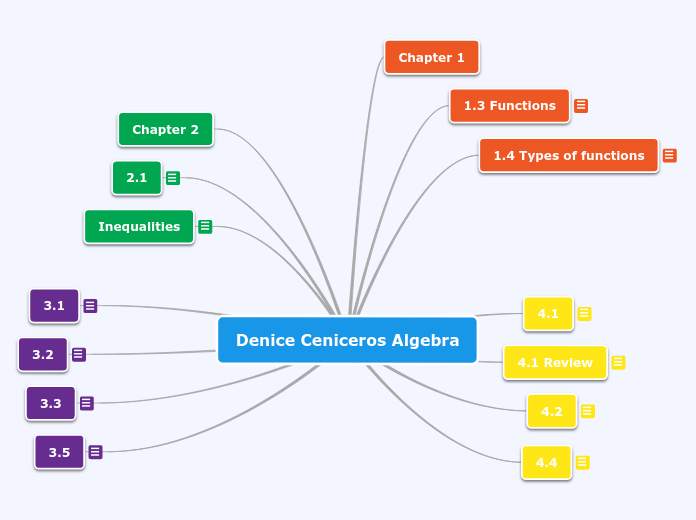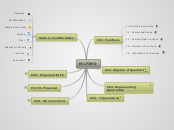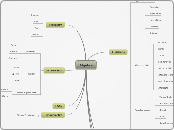Denice Ceniceros Algebra
3.5
Transformation of a graph
- Great auntie- tries to stay near you, go the other direction (parenthesis)
- Example: (x-4) Go to the right 4, opposite of what you are told
- Elevator man- wants to get a tip so follows the same direction as in the equation
- Example: x+5 Go up 5 like the equation says to
3.3
More with imaginary numbers
Note: i= Sqrt -1 , i^2=-1
If a>0 , then sqrt -a = i sqrt a
- Simplify
Example: sqrt -16 Example: sqrt -3 X sqrt -3 | isqrt-3 X -isqrt3
=i sqrt 16 sqrt 9 | i^2sqr3 Xisqrt3
=4i =3WRONG | -1 (3) = -3 RIGHT
Example: 2 +_sqrt-24 Example: sqrt -2 X sqrt -8
2+i sqrt 24 /2 =i sqrt 2 X sqrt 8
2+isqrt 24 /2 i^2 sqrt 16
2+i sqrt 4 sqrt -1 (4)
=-4
i = sqrt -1 i^2=-1
Example: i+i=2i Example: 5i-3i=2i
Example: 5i X 3i= 15i^2 = 15(-1) =-15
Example: 5(-4i)= 20i Example: -6(2i-1)=12i+6
Example: 3i/21= 3/2 Example: (2i+1) (2i-1)= 4i^2-2i+2i-1
=4i^2 -1=4(-1)-1= -5
Complex Conjugates
- (2-3i)^2 2. -1(5-2i)^2
Check Notebook
Complex Conjugates
3 . 4+i/5-i X 5+i/5+i = 20+5i+4i+i^2/ 25-i^2
= 20+9i-1/25+1 = 19+9i/26
Complex Numbers and Exponents
i= Sqrt -1 , i^2=-1 , i^3 = i^2 X i =-1 X i =-i
i^4 =1 , i^5=i^4 X i =i , i^6= i^4 X i^2= -1
i^12= (i^4)^3= 1^3=1 i^50=(i^5)^10= i^10
=(i^2)^25=(-1)^25 = -1
- i^10 2. i^30 3.i^57 3.
3.2
Quadratic Formula
x= -b+- sqrt b^2-4 ac/2a
Graphically- X intercepts
(2 of these)
(1 of these)
Analysis
the Discriminant b^2-4ac
b^2-4ac > 0 2 real solutions
b^2-4ac=0 1 real solution
b^2-4ac <0 2 imaginary solutions
As long as the equation is of the form ax^2+bx+c=0 , I can use the quadratic formula.
Other ways to solve
- Complete the square when in standard form. (changes to vertex form)
Example 1: x^2 -8x +9 =0 1. Move the constant to the other side
x^2 -8x=-9 2. (b/2)^2 (8/2)^2=16
(x^2-8x +16)-16 =-9 3. Add and Subtract (b/2)^2
(x-4)(x+4)=-9+16
Sqrt (x-4)^2 = Sqrt 7 4. Put in vertex form
x-4 = +_ sqrt 7 5. Take square root
Example 2: x^2 - 8x=7 IN NOTEBOOK
Example 3: 3x^2 -6x +z=0
When a=/ 1 ...
3x^2 - 6x= -2
3( x^2 -2x ) =-2
3( x^2 -2x +1 -1)=-2
3(x^2-2x+1)+3(-1) =2
3(x-1)^2 = -2+3
3(x-1)^2 =1
(x-1)^2 =1/3
x-1=+_ Sqrt 1/3
x= 1+_ Sqrt 1/3
Factoring when factorable
Example: 2x^2 +2x-11=1
2x=^2+2x-12=0
2(x^2+x-6)=0
2(x-2)(x+3)=0 Divide by 2
(x-2)(x+3)=0
x-2=0 x+3=0
x=3 x=-3
3.1
- Degree is 2
- F(x)=ax2+bx+c (Standard Form)
- Graph- shape is parabolic (parabola)
If a>0, then upwards parabola
If a<0, then upside down parabola
Ex: Desmos
D:(-infinity, infinity)
{x|-infin. <x<infin.} - all real #'s
R: [0,inin.)
Increasing: (-infin.,0) Decreasing: (0,infin.)
4 . Verex Form f(x)=a(x+h)2+k
(h,k) vertex
Ex: Find the equation given the vertex and a point on the curve.
V= (0,3) (2,1)
Need to find a and the vertex
1=a(2-0)^2+3
−2=a(2−0)2 Answer: f(x)=-1/2(x-0)^2+3
−2=a(4) f(x)= -1/2 x^2+3
−1/4=a
Find the equation given
V=(-2,4) and (3,6) Answer: F(x)= 2/25(x+2)^2
6=a(3+2)^2+4
2=a(5)^2
2/25=a
Find the function form given standard form
Ex: f(x)=2x^2-4x+1
- x-coordinate of the vertex is -b/2a
- y-coordinate F is (-b/2a)
Ex: b=4 a=2 x= --4/2(2)=1
f(1)= 2(1)^2-4(1)+1= -1 V=(1,-1)
Inequalities
- One variable x>−3
x+3x-2<4 --> 4x-2<4
4x<6 --> x<6/4=3/2 I.N = (-3,infinity)
2 . Two variables
Graph to find the solution set
y<3x+2 Test Point (-2,3) --> 3<3(-2)+2__ FALSE
3 . 2x+3y>_ -4
- Test point--(0,0) Answer on Desmos
4 . Absolute Value
|2x|=3
2x=3 or 2x=-3
5 . -2 |5x+10|=-4
-2/-2|5x+10| =-4/-2
|5x+10|<_ 2
5x+10=2 or 5x+10=-2
x<_ -8/5 x>_ -12/5
2.1
2.1 Linear Functions
Types of lines
- y=mx+b - slope-intercept form
- Ax+By=C - standard form
- y-y1=m(x-x1) - point slope
Graphing
y=-2x+3
Parallel Lines-
- Have same slope, different Y intercept
Perpendicular-
- slopes are the opposite reciprocals
Find the equation Given...
- 2 points
- (2,5) (1,0)
m= 0-5/1-2= -5/-1 =5
y-0= 5(x-1)
y=5x-5
2 . A point and the slope
Ex: (3,8) m=4/3
y-8= 4/3 (x-3)
y= 4/3x +4
3 . Line parallel to given line
- same slope m= -1/2 gos through (0,0)
y-0= -1/2 (x-0)
y=-1/2x
4 . Line perpendicular
- negative reciprocal of given slope
m= 3/4 m2= -4/3 through (0,-3)
y--3= -4/3 (x-0)
y+3= -4/3x
y=-4/3 x-3
Chapter 2
4.4
Real zeros of higher degree polynomials
Example: f(x)=x3−612+839x+4221 reps a
Small country's bird population , x days after May 31st.
Find the date(s) when the population was 5000. Find X when when f(x)= 5000 See Notes
Factoring to find zeros f(x)=ax^2+bx+c
F(x)= x^2-3x+2
0=(x-1)(x-2)
x-1=0 x-2=0
x=1 x=2
Zeros with Multiplicity (factored form) Graph
Example: f(x)=(x+2)^3 Example: F(x)= (x-4)^3(x+1)
=(x+2)(x+2) x=2 =4 Multiplicity
x=-1
Complete Factored Form
a) f(x)= 13x^2 -13x-26 b) f(x)=7x^3-2|x^2-7x+2|
GCF = 13 13(x^2-x-2) GCF= 7 (USe grouping method)
=13(x-2)(x+1) 7(x^3-3x^2)-(x-3)
0=13(x-2)(x+1) x=2 x=-1 7 [(x^3-3x^2)-(x-3)]
7[x^2(x-3)-(x-3)]
7(x-3)(x^2-1)
7(x-3)(x-1)(x+1) X=3,1,-1
C) F(x)=2x^3-4x^2-10x+12 (Use Graph)
Factoring Continued
a) f(x)= 2x^3-2x^2-34x-30 with given zero See Notes
If remainder = 0 ... TRUE FACTOR
Rational Zeros (Not all whole # zeros)
Let f(x)=
4.2
Polynomial Functions and Models
- Turning Point - Point when it goes from increasing to decreasing/decreasing to increasing _Cubic Function_
- End Behavior - f(x)--> - infin, x --> - infin
Example: See note book
Intercepts (x and y intercepts)
Example: See notebook x- intercepts (y=0)
zeros
Example: see notebook and desmos
- All intercepts
- End behavior
- Increasing/ Decreasing intervals
- Concavity *Concave up / Concave down*
3 . Piece wise Functions
F(x)= {x x>2 Slope=1
{2 x<_2 y-int=0
^ See notebook
{2x x>0
{x+2 x<0
Project - Compound Interest
FV=PV(1+i)^n
F+P(1+r)^t
#1 and 2# YOU TRY IT
F(x)+ax^2+bx+c F(1+r)^2+b(1+r)+c
4.1 Review
- Transformations of graphs
- Translations/ Reflections
- Minimum
- Maximum
- End behavior
- Increasing/ Decreasing Intervals
- Domain/ Range
- Even/ odd functions
4.1
Non Linear Functions
Symbolic Form for a polynomial
Example: y=mx+b OR f(x)=mx+b
F(x)= ax^m+bx^m-1+cx^m-2+. . . .
Graphs
Min and Max , Absolute Min , Absolute Max , Local Min , Local Max
- End Behavior - Tails
- Increasing/ Decreasing
- Domain/Range
Example: 2x3+3x2+x−1 See Desmos
F(x)--> -infinity as x-->- infinity
F(x)--> infinity as x--> infinity
Example: 2x3+5x2+x−2 See Desmos
Minimum - (-1.404,-3.557) Maximum - (0.5,0)
Increasing: ( Decreasing:
Domain: Range:
1.4 Types of functions
Types of Functions
Linear
Symbolic Form- y=mx+b (Slope intercept form)Highest exponent degree is 1.Ex: y=3x+1(Vertical Line)x=2 (a line that is NOT function)(Horizontal Line) y=2 (is a function)
Quadratic y=ax^2+bx+cHighest Degree is 2.Ex: y=x2+2x+11a. f(x)=3x2+4x+21b. a>02a. a<02b. f(x)=−x2+2x+1
Cubicf(x)=ax3+bx2+cx+d(a,b,c,d are constants)Highest exponent is 3.y=x3 f(x)=6x3a>0 -- Regular parabolaa<0 -- Upside down parabola
Quarticf(x)=ax4+bxcx2+dx+eDegree is 4.Ex:a>0 --a<0 --
Rationalf(x)=a/x−h+kx-h DOES NOT EQUAL 0Ex:f(x)=(3/x+2)
Exponentialf(x)=(a)(bx)(a,b are constants)Ex: a=1 , f(x)=33Ex: f(x)=ex( e is a constant)Ex: a=1/2 f(x)=1/2(2x)Logarithmic Absolute Value Functionsf(x)=∣x−h∣+kEx: f(x)=∣x∣Average rate of change- (Slope)y2−y1/x2−x1=f(x2)−f(x1)/x2−x1Ex: f(x)=2x2 (1,3) find average{interval} rate of changef(−2)−f(−3)/−2−−3(-3,-2)Difference Quotientf(x−h)−f(x)/(x+h)−x = f(x+h)−f(x)/h Ex: f(t)=−16t2+16t+32(0,2) −16t2+16t+32f(0)=32f(2)= 0f(2)−f(0)/2−0=0−32/2−0=−32/2=−16
1.3 Functions
1.3 Functions and their representations
Definitions:
- Variable- a symbol /letter that represents an unknown number
- Dependent Variable- "y" output
- Independent Variable- "x" input
- Equation- two equal algebraic expressions
- Relation- comparing at least two things (usually x and y)
- Function- relation where each input has only one output
- y=x2
- () Not equal
- [] Equal to
Chapter 1








